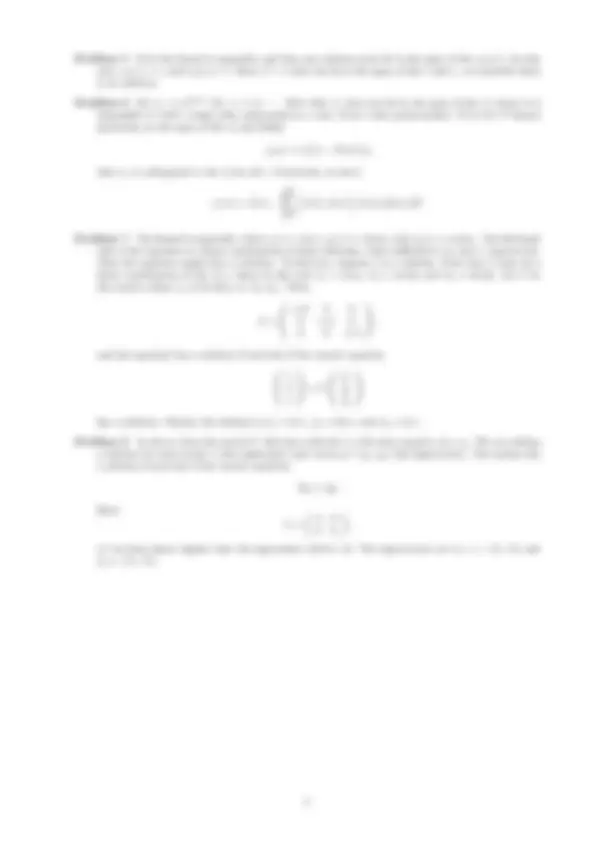



Study with the several resources on Docsity

Earn points by helping other students or get them with a premium plan


Prepare for your exams
Study with the several resources on Docsity

Earn points to download
Earn points by helping other students or get them with a premium plan
Community
Ask the community for help and clear up your study doubts
Discover the best universities in your country according to Docsity users
Free resources
Download our free guides on studying techniques, anxiety management strategies, and thesis advice from Docsity tutors
Material Type: Assignment; Class: Sptp:Optimization; Subject: Mathematics; University: Duquesne University; Term: Fall 2008;
Typology: Assignments
1 / 2

This page cannot be seen from the preview
Don't miss anything!


Math 491/CPMA 591 Inverse Problems Fall, 2008
Problems 3
Problem 1 The following bounds are not necessarily best possible; your answers may be different.
a) ‖h‖ 1 ≤ 2 π, ‖h‖ 2 ≤
2 π, ‖h‖∞ ≤ 1. b) ‖h‖ 1 = 2
2 π, ‖h‖ 2 = ∞, ‖h‖∞ = ∞. c) ‖h‖ 1 = 16 [(3/4)− 3 − 1], ‖h‖ 2 <
47 / 38 , ‖h‖∞ = 2^7 / 34. d) ‖h‖ 11 /e, ‖h‖ 2 = 1 sqrte, ‖h‖∞ = e−^1.
Problem 2 For one norms, if ‖K‖∞ < ∞, the basic calculation is the following:
‖h‖ 1 =
∫ (^) b
a
∫ (^) b
a
K(x, y)h(y)
dx
∫ (^) b
a
∫ (^) b
a
|K(x, y)h(y)| dydx
≤ ‖h‖∞‖K‖∞
∫ (^) b
a
∫ (^) b
a
dydx
= ‖h‖∞‖K‖∞(b − a)^2.
If ‖K‖∞ is not finite but ‖K(·, y)‖ 1 is, the basic calculation for one-norms becomes:
‖h‖ 1 =
∫ (^) b
a
∫ (^) b
a
K(x, y)h(y)
dx
∫ (^) b
a
∫ (^) b
a
|K(x, y)h(y)| dydx
≤ ‖h‖∞
∫ (^) b
a
‖K‖ 1 dx
= ‖h‖∞‖K‖ 1 (b − a).
The calculations for two norms and sup norms are similar. Using these techniques, you can show:
a) ‖q‖ 1 ≤ ‖h‖∞, ‖q‖ 2 ≤ ‖h‖∞, ‖q‖∞ ≤ ‖h‖∞. b) Similar. (More generally: whenever K is bounded and the region is finite, q will have 1,2, and sup norms. c) Here the kernel is not bounded. You can still that show that ‖q‖ 1 , ‖q‖ 2 , and ‖q‖∞ exist, and are bounded by some multiple of ‖h‖∞.
Problem 3 Calculations similar to the above yield:
a) ‖q‖ 1 , ‖q‖ 2 , and ‖q‖∞ exist and are bounded by some multiple of ‖h‖ 1. b) Ditto. c) Here, neither ‖q‖ 1 , ‖q‖ 2 , nor ‖q‖∞ need exist.
Problem 4 Recall that a norm is a positive function which satisfies the triangle inequality and is equal to zero if and only if its argument is zero. Thus:
a) not a norm (has non-zero kernel) b) norm (verify) c) not a norm (could be negative)
Problem 5 Note the kernel is separable, and thus any solution must lie in the span of the αi(x)’s. In this case, α 1 (x) = x and α 2 (x) = 1. Since x^2 + 1 does not lie in the span of the 1 and x, we conclude there is no solution.
Problem 6 Set ψˆi := y100+1^ for i = 1, 2 , · · ·. Note that ψˆi does not lie in the span of the βi (since it is impossible to write a high order polynomial as a sum of low order polynomials.) If we let P denote projection on the span of the βi and define
ψi(x) = ψ(ˆx) − P ( ψ(ˆx)),
then ψi is orthogonal to the βi for all i. Concretely, we have:
ψi(x) = ψˆ(x) −
j=
ψ(ˆx), βi(x)
βi(x)/‖βi(x)‖^2.
Problem 7 The kernel is separable, with α 1 (x) = sin x, α 2 (x) = sin 2x, and α 3 (x) = cos 2x. The left hand side of the equation is a linear combination of these elements, with coefficients 1,3, and 1, respectively. Thus the equation might have a solution. To find out, suppose f is a solution. Note that f must be a linear combination of the βi’s, where in this case β 1 = cos y, β 2 = cos 2y, and β 3 = sin 2y. Let Γ be the matrix whose (i, j)’th entry is 〈βi, βj 〉. Then
π/ 2 0 0 0 π/ 4 0 0 0 π/ 4
and the equation has a solution if and only if the matrix equation
f 1 f 2 f 3
has a solution. Clearly, the solution is f 1 = 2/π, f 2 = 12/π, and f 3 = 4/π.
Problem 8 As above, form the matrix Γ, this time with the (i, j)th entry equal to 〈βi, αj 〉. We are seeking a solution for some scalar λ (the eigenvalue) and vector y = [y 1 , y 2 ] (the eigenvector). The system has a solution if and only if the matrix equation
Γy = λy.
Since Γ =
we see from linear algebra that the eigenvalues will be ±8. The eigenvectors are v 1 = [−. 71 , .71] and v 2 = [. 71 , .71].